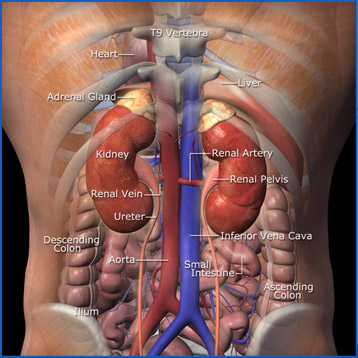The kidneys are bean-shaped organs, each about the size of a fist. They are located near the middle of the back, just below the rib cage, one on each side of the spine. The kidneys are sophisticated reprocessing machines. Every day, a person’s kidneys process about 200 quarts of blood to sift out about 2 quarts of waste products and extra water. The wastes and extra water become urine, which flows to the bladder through tubes called ureters. The bladder stores urine until releasing it through urination.
Wastes in the blood come from the normal breakdown of active tissues, such as muscles, and from food. The body uses food for energy and self-repairs. After the body has taken what it needs from food, wastes are sent to the blood. If the kidneys did not remove them, these wastes would build up in the blood and damage the body.


The actual removal of wastes occurs in tiny units inside the kidneys called nephrons. Each kidney has about a million nephrons. In the nephron, a glomerulus-which is a tiny blood vessel or capillary-intertwines with a tiny urine-collecting tube called a tubule. The glomerulus acts as a filtering unit, or sieve, and keeps normal proteins and cells in the bloodstream, allowing extra fluid and wastes to pass through. A complicated chemical exchange takes place, as waste materials and water leave the blood and enter the urinary system.
At first, the tubules receive a combination of waste materials and chemicals the body can still use. The kidneys measure out chemicals like sodium, phosphorus, and potassium and release them back to the blood to return to the body. In this way, the kidneys regulate the body’s level of these substances. The right balance is necessary for life.
In addition to removing wastes, the kidneys release three important hormones:
- erythropoietin, or EPO, which stimulates the bone marrow to make red blood cells
- renin, which regulates blood pressure
- calcitriol, the active form of vitamin D, which helps maintain calcium for bones and for normal chemical balance in the body
Functions of the Kidneys
Excretory Functions
- Fluid Balance
- Electrolyte Balance
- Acid/Base Balance
- Removal of Metabolic waste product
Hormonal Functions
- Regulation of BP
- RBC production
- Vit. D. Metabolism
FLUID BALANCE
- Blood flow through the kidney is about 20% of each heartbeat (about 1200 ml/min)
- A person’s total blood supply circulates through the kidneys (approximately 12x/hr)
- 125 ml/min of fluid is REMOVED from the blood, however 124 ml/min of fluid is RETURNED to the blood.
- 1 ml/min OF URINE IS PRODUCED (1500 ml/day)
ELECTROLYTE BALANCE
- Proximal Convoluted Tubule – glucose, amino acids, water, salts and some urea is reabsorbed
- ALDOSTERONE is secreted by the adrenal gland which causes SODIUM retention and secretion of POTASSIUM & HYDROGEN IONS is the tubule
- PTH is secreted by the parathyroid glands which causes reabsorption of CALCIUM and PHOPHORUS in the tubules
ACID BASE BALANCE
- Catabolism increases carbon dioxide production
- Acids are produced by metabolism of fats and carbohydrates
- Some bases are created by protein metabolism
- Compensation is what the body does to maintain a balance of acid and base
– Kidneys increase or decrease bicarbonate reabsorption or increase or decrease hydrogen ion secretion
– Lungs also compensate by increasing or decreasing respirations to correct.
REMOVAL OF METABOLIC WASTE PRODUCTS
- Urea (Normal: 10 -20 mg/dl)
– A by product or protein metabolism - Creatinine (Normal: 0.6 – 1.2 mg/dl)
– A by product of muscle metabolism - Uric Acid ( Normal: 2.0 – 7.5 mg/dl)
– A by product of protein/purine metabolism which comes from organ meats, fish, beans, alcohol
Kidney Failure
Renal failure may be acute or chronic. In both there is enough loss of nephron function to upset the normal steady state of the body’s internal environment. Waste products of protein metabolism accumulate. This is termed azotemia, indicating retention of nitrogenous products (azote = nitrogen). Azotemia is a major component of the uremic syndrome.
Uremic syndrome encompasses a complex of symptoms and findings resulting from disordered biochemical processes when kidney function fails. Severity of the uremic symptoms parallels the rise in blood urea. Urea clearly contributes to some of the symptoms – malaise, lethargy, anorexia, insomnia, but it is not the primary toxin od uremia. Numerous other substances are retained in the body when kidney function fails.
Acute Renal Failure
It is any sudden, severe impairment of kidney function. Onset is rapid, over hours or a few days. Clasicaly there is oliguria (less than 400 mL of urine per 24 hours)
Causes of ARF (Acute Renal Failure)
- Prerenal causes reduced blood flow to the kidney sufficiently to impair function. The most common causes include low extracellular fluid volume ( as in severe dehydration), heart failure, and blockage of the renal arteries.
- Intrarenal (intrinsic) is caused by direct damage to kidney tissue. This might occur with an acute inflammation (rapidly progressive glomerulonephritis). Much more often, it is the result of severely compromised blood flow (hemorrhagic shock) or direct toxicity to kidney parenchymal cells; this can come from some antibiotics, myoglobin, or ethylene glycol. The result is acute tubular necrosis, which causes 75% of all acute renal failure. Commonly called ATN, this condition
- Postrenal causes blocked flow of urine leaving the kidney. Obstruction may be at the ureter, bladder or urethral level.
Identification of prerenal and postrenal causes is important because often they may be corrected quickly, without residual damage to the kidneys.